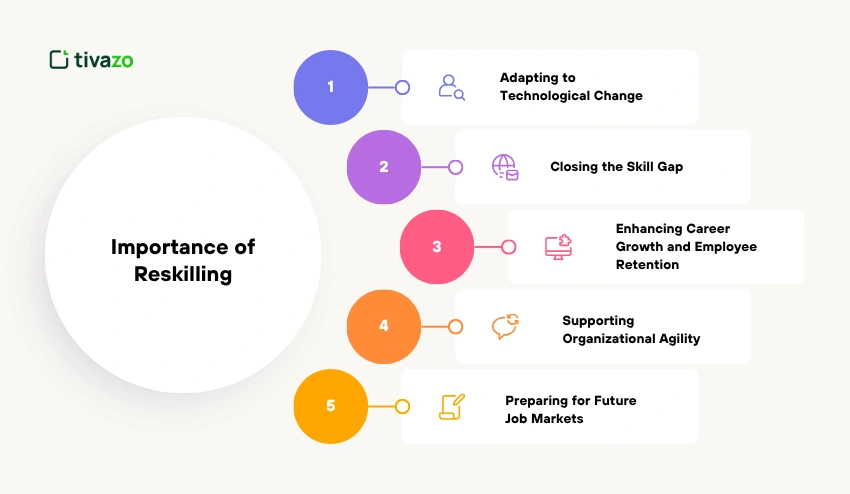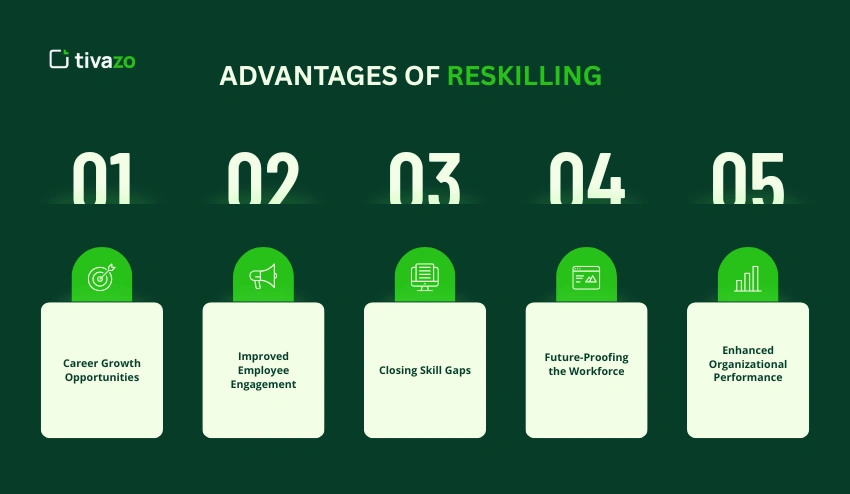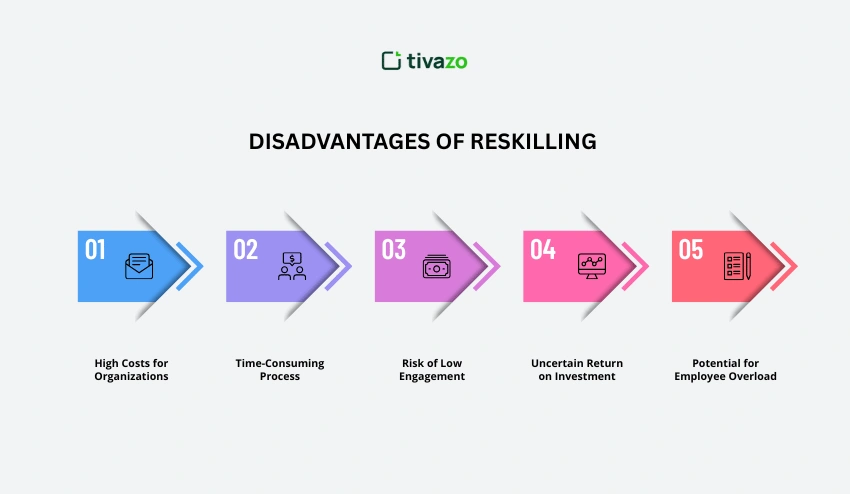Imagine the following: your industry is changing more than ever, and the skills that previously made you successful are no longer sufficient. Technology, automation, and AI are changing the manner in which we work, and the only question that remains is how do you remain relevant?
This is where reskilling fits in. But what is reskilling, and what is the real benefit of reskilling your career? Reskilling refers to acquiring new skills to fit the new roles, industry, and technologies to be useful in the new workforce.
Here in this blog, we will explore what reskilling actually is, its effects on employees and businesses, and why reskilling is becoming a crucial aspect of professional development. We will also identify the most important differences between reskilling and upskilling, practical examples, benefits, issues, and the ways companies such as Tivazo are contributing to reducing talent gaps by implementing smart reskilling.
What is Reskilling?
Reskilling is the process of learning new skills to take on a different role or adapt to changes in your current job. It helps employees stay relevant as industries evolve and new technologies emerge, ensuring they remain valuable in the workforce.
What is Reskilling for Employees?
Reskilling for employees means providing workers with new skills that enable them to move into different roles within the same organization or adapt to changing job requirements. It ensures employees can stay productive and valuable as business needs and technologies evolve.
What is Reskilling in Business?
Reskilling in business can be defined as the process through which organizations train their employees in new skills that meet the emerging business needs, technological advancements, and business objectives. It keeps businesses competitive and, at the same time, maintains talented employees.
The businesses need to keep evolving as industries are rapidly becoming more innovative and automated. The reskilling programs enable firms to solve the skills gap, enhancing employee performance and lowering turnover.
Why is Reskilling Becoming so Important?
Reskilling is becoming increasingly important because rapid technological advancements, automation, and changing industry demands are creating skill gaps that threaten both employee careers and organizational growth.
Importance of Reskilling

1. Adapting to Technological Change
In the digital transformation age, which has restructured industries, employees are subjected to continuous changes in the skills they need. Reskilling keeps employees up-to-date as they get to learn new tools, software, and processes that they should use to work in a technology-driven world.
Companies investing in reskilling initiatives have a guarantee that their employees can adjust to automation and artificial intelligence without any major setbacks. The employees become confident about the use of new technologies that enhance productivity and decrease the chances of job loss.
Finally, technological change reskilling fosters the culture of lifelong learning and prepares employees as well as organizations to succeed in the fast-changing work environment.
2. Closing the Skill Gap
There is a shortage of talent in such critical sectors as data analytics, digital marketing and cybersecurity, as experienced by many companies. Reskilling fills these gaps by training employees to possess the most required competencies by businesses.
It is also beneficial to the employees since reskilling programs enable them to gain marketable skills that enable career progress and increase their employability. This also enhances employee engagement and minimizes employee turnover through commitment towards professional development.
Reskilling makes companies focus on the capacities of the workforce and align them with strategic objectives, providing a competitive edge and a future-ready organization.
3. Enhancing Career Growth and Employee Retention
Reskilling is no longer a strategic tool in an organization; it is a career savior. When employees constantly refresh their skills, they are of value in their present jobs or are ready to get a promotion and new experiences in the same company.
The provision of structured reskilling programs enhances the loyalty of employees as well. When employees know that their organization is investing in their growth, chances are high that they will remain with it and save on recruitment expenses and institutional knowledge.
Furthermore, reskilling makes employees assume control over their career development, producing a motivated, flexible, and engaged workforce that succeeds despite the disruption of the industry.
4. Supporting Organizational Agility
The modern business world is very dynamic and requires companies to change gears within a short span of time to stay afloat. Reskilling will provide the ability for teams to assume new roles and responsibilities without major delays.
Organizations implementing reskilling tactics develop a flexible workforce that can address new demands, including the use of new software, remote work teams, or new markets.
This agility enables any business to innovate quickly, react to the market, and maintain growth, and employees achieve a wider range of skills that improve their career path.
5. Preparing for Future Job Markets
The employment sector is changing more than ever before, and new positions are being created as others are being phased out. Reequipping provides employees with the skills to survive in the new career and keep pace with the changes in the industry.
Organizations invest in reskilling programs to allow employees to acquire in-demand skills, including data analysis, digital communication, and AI literacy. This makes the workforce agile and employable at all times to address the arising challenges.
Finally, reskilling equips individuals and companies with the chance of long-term success and enables them to capitalize on opportunities in the constantly evolving professional environment, reducing the chances of being affected by the skills obsolescence factor.
What is the difference between reskilling and upskilling?
| Aspect | Reskilling | Upskilling |
| Definition | Reskilling is the process of learning entirely new skills to transition into a different job role or adapt to a new career path. | Upskilling is the process of enhancing existing skills to perform better in your current role or advance within the same career path. |
| Purpose | To enable employees to take on new roles and adapt to changing industry demands. | To improve efficiency, productivity, and expertise in the current role. |
| Focus Area | Learning new skills that were not part of the employee’s previous job function. | Building on current skills or knowledge to stay updated and excel in the same role. |
| Examples | A customer support agent is learning coding to move into a software development role. | A digital marketer learning advanced SEO strategies to improve campaign performance. |
| Impact on Career | Broadens career opportunities and enables workforce mobility. | Strengthens current role performance and prepares for promotions within the same field. |
| Organizational Benefit | Helps close skill gaps and supports workforce transformation. | Boosts productivity and employee engagement while retaining talent. |
What is an example of reskilling?
Reskilling is the acquisition of new skills that will help workers move to new positions or accommodate the changes in their line of work. Life cases show how reskilling can help staff and companies to remain competitive in an ever-changing job market.
1. IT Professional Moving into Cybersecurity
The ideal scenario of reskilling is an IT support specialist who has enrolled in online courses or even company training on cybersecurity. With skill in the areas of threat analysis, network security, and compliance, the employee is able to shift to the high-demand in cybersecurity positions to meet the demands of the company in digital security and future-proof their careers.
2. Retail Worker Transitioning to E-commerce
A retail employee who has been reskilled in digital marketing, data analytics, or e-commerce operations will be able to transition to online sales and management. This form of reskilling prepares employees to take up the expanded requirement of online business proficiency through modern Ecommerce Platforms and enhances their future workability.

3. Manufacturing Staff Learning Automation Tools
Reskilling is experienced when factory workers are trained in robotics, software to operate machines, or how to perform automation in industries. Not only do these employees benefit the company, but also their own career development as they develop the technical skills required to use high-tech equipment, which is also efficient for the company.
4. Customer Service Staff Adopting AI Tools
Reskilling Customer service representatives who get trained on how to handle AI-based support systems or CRM programs are reskilling to boost productivity. Through the adoption of new digital tools, employees remain relevant and help to enhance customer experience, which is the concrete outcome of reequipping programs.
All these examples demonstrate that reskilling has no particular industry or job. Through reskilling, employees will be able to embrace technological change, reduce skills gaps, and gain career development as organizations develop a more agile and future-ready workforce.
What are the advantages of reskilling?

1. Career Growth Opportunities
Among the key benefits of reskilling is the fact that it creates new career opportunities and advancements. Being able to transfer employees who develop new skills to jobs that suit their interests or industry needs enhances job satisfaction and long-term employability.
In the case of organizations, reskilling should be encouraged as it allows the company to retain the best employees by offering them a sense of clear career development. It also makes sure that the employees are prepared with the skills they require to assume more strategic or advanced positions that will help in the overall business development.
2. Improved Employee Engagement
Reskilling programs enhance the motivation and involvement of the employees by indicating that they are being invested in by the company. Employees also develop a sense of appreciation when they are allowed to acquire new skills to improve their job opportunities.
The productive and loyal employees are engaged, thus lowering the turnover rate and the cost of recruitment. By focusing on reequipping, organizations establish a favorable work culture that is based on learning, development, and flexibility.
3. Closing Skill Gaps
Skill gaps may also be a source of poor performance and innovation in rapidly changing industries. Reskilling fills these gaps through educating employees on skills that are required to respond to evolving business requirements.
This is a benefit that will make sure that companies possess a workforce that is able to deal with the emerging technologies, new processes, and market changes. This is also beneficial to the employees since they acquire relevant and in-demand skills that enhance their performance and career opportunities.
4. Future-Proofing the Workforce
With industries being redefined by automation and AI, a lot of the traditional jobs are changing or being eliminated. Reskilling assists employees in adjusting by acquiring skills that can be marketable in the future to keep their jobs.
In the case of businesses, reskilling provides a future-proofing of the workforce, which will allow the company to be flexible and competitive. This preemptive strategy minimizes the chances of skills shortage and builds resilience in the organization in the long term.
5. Enhanced Organizational Performance
Reskilling enhances the overall performance of the organization as it makes sure that the employees are equipped with the necessary skills to cope with the changing business demands. With the updated competencies provided to the workers, projects become more efficient, faster in terms of innovation, and quality is improved across teams.
Strategically, reequipping provides companies with an opportunity to stay competitive in an industry that evolves at an extremely high rate. The ability of a workforce to be flexible to new technologies, processes, and customer demands is a direct contributor to long-term growth and sustainable success.
All in all, reskilling is a win-win situation for both the employees and the organizations. It promotes career development, interest, and flexibility, as well as enabling companies to bridge skills gaps and prepare for the future of work.
What are the disadvantages of reskilling?
Despite the many benefits of reskilling, there exist some issues that can be undertaken to be faced by employees and organizations. These drawbacks can be studied to implement more efficient reskilling programs and reduce the risks of these risks.

1. High Costs for Organizations
Reskilling programs may also be costly to the company in terms of training resources, such as online courses, training materials, and professional trainers. Small and medium-sized businesses might have difficulty in setting aside adequate resources without compromising other operational budgets of operations.
Besides, the price is not confined to financial outlay. Planning, implementation, and tracking reskilling would require time and management focus of companies, which might temporarily reduce the attention to the core business processes.
2. Time-Consuming Process
Reskilling is also a time-consuming process that employees must dedicate their time to acquire new skills as they handle their job duties. Short-term stress and low productivity may result when training is combined with the day-to-day work.
In the case of organizations, it can be complicated to organize reskilling programs and make sure that the employees are able to pass through the training. Unless time-intensive programs are planned, they may interrupt workflows and slow the work of a team.
3. Risk of Low Engagement
Employees do not have the same motivation to join reskilling programs. Without interest or motivation to change, there may be low engagement, resulting in less effectiveness of the program.
Organizations need to develop reskilling initiatives that are meaningful, interesting, and consistent with the career interests of employees. Otherwise, the return on investment in training might not be the anticipated skills growth or workforce flexibility.
4. Uncertain Return on Investment
The payoffs of reequipping programs, despite having a well-planned reskilling program, may not be assured. The new skills may make the employees quit the company, or the new skills may not be fully relevant to the needs of the company in the future.
When performing reskilling, organizations must be very careful in evaluating which positions and skills are the most needed to make sure that the process results in tangible business and career results and not in the consumption of resources.
5. Potential for Employee Overload
Reskilling may at times overwhelm the employees who are supposed to be learning new skills and still perform their usual duties. Unless dealt with appropriately, this pressure can cause stress and burnout, or loss of job satisfaction.
Since organizations are supposed to maintain a balance between training and everyday duties, it is important not to overwork the employees. Unless Retraining programs are properly planned, they will adversely affect productivity and morale, defeating the purpose of developing skills.
In as much as reskilling is an effective workforce skill that enables workforce flexibility, it also has its own setbacks, which include high cost, time requirements, problems in engaging employees, and ambiguous returns. It is the knowledge of these drawbacks that assists organizations in strategizing more effective programs that will maximize their benefits both to the employees and the business.
Why are companies failing at reskilling?
The difficulty in reskilling is faced by many companies due to their underestimation of resources, planning, and engagement needed to turn the programs into an effective one. Run-of-the-mill problems include failure to understand what it is about, not aligning with the business objectives, inadequate training facilities, and a lack of motivation on the part of the employees.
Companies do not always analyse the levels of specific skills gaps in the workforce and hence end up in generic training, which is irrelevant to the actual requirement. Lack of a strategic roadmap can lead to wastage of time, low levels of participation, and little effect on the workforce productivity in reskilling efforts.
Also, the companies occasionally do not pay attention to the necessity of constant support and follow-up. Employees are required to have constant mentoring, practical application opportunities, and guidance even after training to fully integrate their new skills. This is something that should not be provided, and as a result, the retention of knowledge and the payoff of reskilling programs are minimal.
Getting Started with Tivazo
Tivazo is a SaaS-based employee monitoring and time tracking software, which allows remote and on-site workers to understand the way their working hours are allocated more effectively. The ability to monitor daily activities will enable businesses to identify tasks and inefficiencies that take up too much time, and time can be well spent by employees to reskill and improve professionally. Having distinct knowledge of the patterns of productivity, the employees can focus on the development of new skills, training, or digital tool use, and make sure that their work can bring something significant to their professional development.
In the case of businesses, Tivazo offers actionable analytics, which will point to how workforce efficiency can be increased and the places employees can be enrolled in targeted Retraining programs. Managers are able to make informed decisions that can be used to support skill development programs, close skills gaps, and promote a learning society. Using Tivazo to manage time, companies can make reskilling a planned, quantifiable, and effective process in employee development. To learn more about Tivazo, visit www.tivazo.com.
Conclusion
Reskilling has become an important tactic that employees and businesses have to employ in a fast-changing world that is highly technological to stay afloat and competitive. Through acquiring new skills, employees are able to adapt to changing roles, bridge any skill gaps, and open new career opportunities, as well as organizations will have a more agile, productive, and engaged workforce. Although these problems are quite common in strategic Retraining, strategic Retraining programs with the help of such tools as Tivazo allow companies to monitor productivity, spend time on learning effectively, and guarantee tangible improvement.
Reskilling not only makes careers future-proof, but it also leads to long-term organizational success, which is why it must be considered a high priority in the modern changing professional environment.




